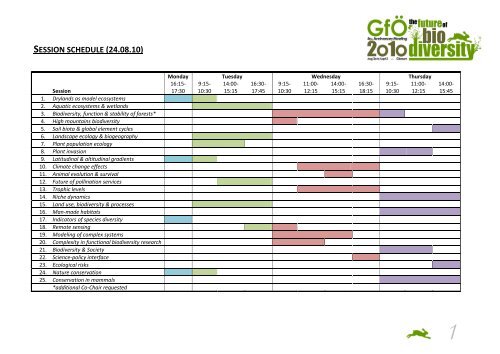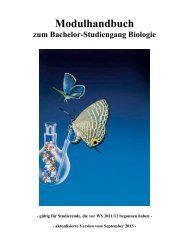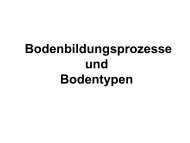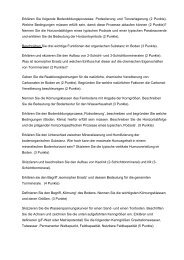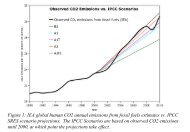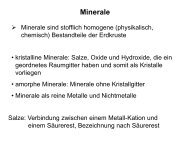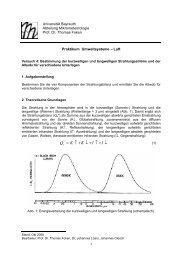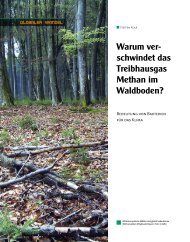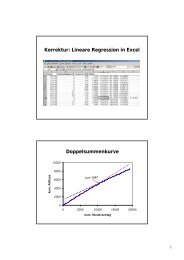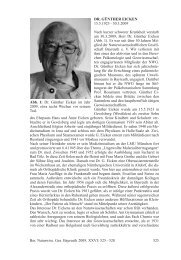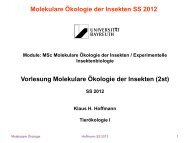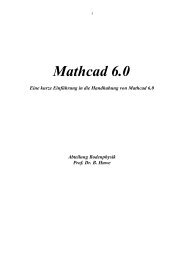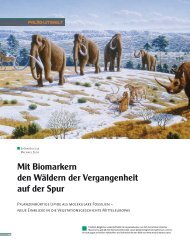SESSION SCHEDULE (24.08.10) - BayCEER
SESSION SCHEDULE (24.08.10) - BayCEER
SESSION SCHEDULE (24.08.10) - BayCEER
Create successful ePaper yourself
Turn your PDF publications into a flip-book with our unique Google optimized e-Paper software.
<strong>SESSION</strong> <strong>SCHEDULE</strong> (<strong>24.08.10</strong>)<br />
1.<br />
Session<br />
Drylands as model ecosystems<br />
2. Aquatic ecosystems & wetlands<br />
3. Biodiversity, function & stability of forests*<br />
4. High mountains biodiversity<br />
5. Soil biota & global element cycles<br />
6. Landscape ecology & biogeography<br />
7. Plant population ecology<br />
8. Plant invasion<br />
9. Latitudinal & altitudinal gradients<br />
10. Climate change effects<br />
11. Animal evolution & survival<br />
12. Future of pollination services<br />
13. Trophic levels<br />
14. Niche dynamics<br />
15. Land use, biodiversity & processes<br />
16. Man-made habitats<br />
17. Indicators of species diversity<br />
18. Remote sensing<br />
19. Modeling of complex systems<br />
20. Complexity in functional biodiversity research<br />
21. Biodiversity & Society<br />
22. Science-policy interface<br />
23. Ecological risks<br />
24. Nature conservation<br />
25. Conservation in mammals<br />
*additional Co-Chair requested<br />
Monday Tuesday Wednesday Thursday<br />
16:15-<br />
17:30<br />
9:15-<br />
10:30<br />
14:00-<br />
15:15<br />
16:30-<br />
17:45<br />
9:15-<br />
10:30<br />
11:00-<br />
12:15<br />
14:00-<br />
15:15<br />
16:30-<br />
18:15<br />
9:15-<br />
10:30<br />
11:00-<br />
12:15<br />
14:00-<br />
15:45<br />
1
<strong>SESSION</strong> <strong>SCHEDULE</strong> (<strong>24.08.10</strong>)<br />
1) Drought, stress, variability, adaptation: Drylands as model ecosystems<br />
(Anja Linstädter & Karsten Wesche)<br />
Scheduled: Monday 16h15 – Tuesday 10h30<br />
ORALS<br />
1. The dispersal-dormancy trade off in dryland annuals - putting model predictions to a<br />
test<br />
Katja Tielbörger, Wolfgang Siewert<br />
2. Effect of plant-plant interactions on phylogenetic structure of a Mediterranean plant<br />
community along an aridity gradient<br />
Raúl García Camacho, Johannes Metz, Katja Tielbörger<br />
3. Vegetation border lines in arid areas depending on topography and surface processes<br />
Sarah Christine Strähl<br />
4. Zonal or azonal? The contribution of termite mounds as microhabitats for the floristic<br />
diversity of West Africa Savannas<br />
Arne Erpenbach, Karen Hahn-Hadjali, Rüdiger Wittig<br />
5. Plant species responses to grazing and climate manipulations along the Jordan River<br />
Valley<br />
Mark Bilton, Johannes Metz, Sara Bangerter, Katja Tielbörger<br />
6. Dryland pastures: How to find indicators in a highly variable system?<br />
Anja Linstädter, Gisela Baumann<br />
7. Rain-use efficiency: A concept revisited. Recent challenges and possible approaches<br />
Jan Ruppert, Anja Linstädter<br />
8. Modelling livestock numbers in the Gobi desert: responses to variation in climate and<br />
productivity<br />
Karsten Wesche, Henrik von Wehrden, Petra Kaczensky<br />
9. The role of key resources to ensure sustainable range management - a modeling study<br />
Romina Drees, Birgit Müller, Karin Frank, Anja Linstädter<br />
10. Benefits of pattern oriented parameterisation for generic models with an example from<br />
semi-arid rangeland management<br />
Oliver Jakoby, Volker Grimm, Martin F. Quaas, Karin Frank<br />
POSTER<br />
1.1. Impact of Retama raetam and biological soil crust cover on the distribution of<br />
nutrients in a semiarid dune ecosystem, NW Negev<br />
Sylvie Drahorad, Peter Felix-Henningsen<br />
1.2. Response of dryland natural vegetation to simulated change of climate and land use<br />
Katja Geißler, Martin Köchy, Florian Jeltsch<br />
1.3. Feedbacks between vegetation and hydrology with a special view on extreme events in<br />
Israel<br />
Stefanie Prange, Katja Geißler<br />
1.4. Plant biodiversity and phylogenetic diversity patterns of the southern Mongolian Gobi<br />
Jan Treiber, Henrik von Wehrden, Jan Hanspach, Jürgen Kluge, Karsten Wesche<br />
2
1.5. Effects of the savanna woody species Acacia mellifera and Tarchonanthus<br />
camphoratus on soil chemistry<br />
Juliane Trinogga, Kerstin Wiegand, David Ward, Sabine Reinsch, Jana Schleicher, Ingo<br />
Schöning<br />
1.6. Response of chlorophyll fluorescence, photosynthesis and transpiration in Robinia<br />
pseudoacacia L. to drought stress<br />
Maik Veste, Wolf-Ulrich Kriebitzsch<br />
3
2) Biodiversity of aquatic ecosystems and wetlands (Jürgen Marxsen,<br />
Stefan Hotes & Elisabeth Pohlon)<br />
Scheduled: Tuesday 9h15 – 17h45<br />
ORALS<br />
1. Spatial and temporal variations of deep-sea bacterial diversity at the Arctic long-term<br />
observatory HAUSGARTEN<br />
Marianne Jacob, Alban Ramette, Thomas Soltwedel, Michael Klages, Antje Boetius<br />
2. Effect of seawater acidification on microbial community diversity – lessons from<br />
natural CO2 leaks<br />
Judith Neumann, Alban Ramette, Matthias Haeckel, Dirk deBeer, Fumio Inagaki, Antje<br />
Boetius<br />
3. Role of seed bank and vegetative growth in re-colonization of gaps in Baltic salt<br />
grassland vegetation<br />
Kristin Ludewig, Antonia Wanner, Kai Jensen<br />
4. Large lakes of Holarctic as donors and recipients of aquatic invasions<br />
Nina Bogutskaya, Marina Orlova<br />
5. Why does restoration of aquatic macrophytes fail? A case study on Potamogeton<br />
malaianus at Lake Kasumigaura, Japan<br />
Stefan Hotes, Jun Nishihiro, Izumi Washitani<br />
6. Use of cross-taxon congruence analysis to identify potential surrogate taxa for<br />
freshwater biodiversity<br />
Margherita Gioria<br />
7. Quantifying the simultaneous effects of multiple pressures on the biodiversity of<br />
agricultural ponds to obtain an integrated indicator<br />
Taku Kadoya, Munemitsu Akasaka, Takashi Aoki, Noriko Takamura<br />
8. Assessing responsible species traits for local extinction of aquatic macrophytes:<br />
Impact of urbanization and bank protection<br />
Munemitsu Akasaka, Shinsuke Higuchi, Mitsuhashi Hiromune, Takamura Noriko, Kadono<br />
Yasuro<br />
9. Rhizosphere dynamics of 3 riparian plant species from TGR water fluctuation zone – A<br />
floodable rhizobox as an approach to observe oxygen, pH and soil solution properties<br />
in high resolution<br />
Christina M. Schreiber, Ulrich Schurr, Bo Zeng, Agnes Höltkemeier, Arnd J. Kuhn<br />
10. Longitudinal distribution of riparian vegetation in a Chinese temporary stream<br />
Chen Xiu, Mathias Scholz, Christiane Ilg, Zhiyun Ouyang<br />
11. A trait-based method to assess pesticide effects on freshwater communities and to<br />
evaluate the efficiency of buffer strips for mitigation<br />
Mira Kattwinkel, Jeanette Völker, Dietrich Borchardt, Matthias Liess<br />
12. Changes of plant diversity in riparian grassland after extreme hydrologic events – A<br />
case study at the Elbe, Germany<br />
Franziska Konjuchow, Peter J. Horchler, Judith Glaeser, Christiane Ilg, Eva Mosner, Mathias<br />
Scholz<br />
13. Reaction of carabid beetles to the extreme summertime flood event of the river Elbe in<br />
2002<br />
Veronica Agostinelli, Michael Gerisch, Frank Dziock<br />
14. Simulating the population dynamics of Corbicula fluminea under varying environmental<br />
conditions – An energy budget based approach<br />
Gunnar Petter, Otto Richter, Sylvia Moenickes<br />
4
15. 15 MIN DISCUSSION TIME<br />
POSTER<br />
2.1. Habitat mapping in the german Wadden Sea<br />
Ina Bruening, Dietmar Kraft<br />
2.2. Ship-induced waves alter the macrozoobenthos community composition of the Havel<br />
River by favouring neozoa<br />
Friederike Gabel, Xavier-Francois Garcia, Martin Pusch, Norbert Walz<br />
2.3. Habitatverlust von Auenwiesen in Norddeutschland seit den 1950er Jahren<br />
Benjamin Krause, Heike Culmsee, Karsten Wesche, Erwin Bergmeier, Christoph Leuschner<br />
2.4. Men induced long term vegetation changes in the Ciénaga Grande de Santa Marta<br />
(Colombia)<br />
Marie-Luise Schnetter, Marina Röderstein, Laura Perdomo, Carlos Villamil<br />
2.5. Characterization of temporary ponds situated on alluvial fans in the Csík Basin (Eastern<br />
Carpathians, Romania)<br />
László Demeter, Anna-Mária Csergő, Gabriella Péter, Edina Miklós, Éva György<br />
2.6. Estimating the effect of global change on riverine carbon dynamics – an Amazon case<br />
study<br />
Fanny Langerwisch, Anja Rammig, Kirsten Thonicke, Wolfgang Cramer<br />
2.7. Vegetation of floodplain meadows along the climatic gradient at the Middle Elbe river<br />
Lotte Korell, Kristin Ludewig, Franziska Konjuchow, Mathias Scholz, Kai Jensen<br />
2.8. Following the footsteps of the zebra mussel – a new freshwater mussel alarms Europe<br />
Katharina C. M. Heiler, Sascha Brandt, Christian Albrecht and Thomas Wilke<br />
5
3) Biodiversity, function and stability of forests (Annett Wolf, Anja<br />
Rammig & Fanny Langerwisch)<br />
Additional session chair for the talks 18-24 required<br />
Scheduled: Wednesday 09h15 – Thursday 10h30<br />
ORALS<br />
1. TRY - a global database of plant functional traits<br />
Jens Kattge, Gerhard Bönisch, Sandra Diaz, Sandra Lavorel, Paul Leadley, Colin Prentice<br />
2. Effect of forest cover continuity over time on plant species diversity and composition in<br />
a Mediterranean area<br />
Valerio Amici, Giovanni Bacaro, Francesco Geri, Elisa Santi, Alessandro Chiarucci<br />
3. Life from related scales of investigation in mountain forests<br />
Michael Rudner, Frank Bode, Melanie Manegold<br />
4. Pattern and process of large-scale tree mortality waves in the mountains of the SW<br />
United States<br />
Harald Bugmann, Alison Macalady<br />
5. May climate change driven ENSO droughts affect forest stability in Southeast Asia?<br />
Bernhard Schuldt, Gerald Moser, Michael Köhler<br />
6. Water relations of mature Picea abies under future CO2 concentrations<br />
Sebastian Leuzinger, Roman Zweifel, Martin Bader, Christian Körner<br />
7. Interaction between Douglas fir and European beech<br />
Martin Haßdenteufel, Willy Werner, Frank M. Thomas<br />
8. Neighbourhood relations and influence of diversity and sloping terrain in a subtropical<br />
Chinese forest<br />
Anne Christina Lang, Werner Härdtle, Goddert von Oheimb<br />
9. Repeller, attractor and neutral tree species in tropical rain forests<br />
Andreas Huth, Thorsten Wiegand, C. V. Salvitri Gunatilleke, I. U.A. Nimal Gunatilleke<br />
10. Multi-scale spatial genetic structure of an understory shrub in subtropical evergreen<br />
broad-leaved forest<br />
Xueqin Zeng, Walter Durka<br />
11. Forest regeneration dynamics in differently disturbed South African scarp forests<br />
Alexandra Botzat, Lena Fischer, Nina Farwig<br />
12. Successional stages and species-specific traits influences on the response of oldgrowth<br />
temperate rainforests to climate change<br />
Alvaro G. Gutierrez, Andreas Huth<br />
13. The significance of intraspecific trait variability in modelling forest growth<br />
Klara Dolos, Björn Reineking<br />
14. Constant functional diversity during secondary succession of a subtropical forest in<br />
China<br />
Martin Böhnke, Wenzel Kröber, Erik Welk, Christian Wirth, Helge Bruelheide<br />
15. Estimation of biomass and NPP in Tugai Forests of Central Asia<br />
Allan Buras<br />
16. Productivity of trees in deciduous temperate forests related to different climatic<br />
conditions<br />
Mascha Jacob, Frank M Thomas, Christoph Leuschner<br />
6
17. Will the CO2 fertilization effect in forests be offset by reduced tree longevity?<br />
Harald Bugmann, Christof Bigler<br />
18. Forest management and gastropod diversity<br />
Heike Kappes<br />
19. Effects of tree diversity on insect herbivory in subtropical forests of southeast China<br />
Andreas Schuldt, Martin Baruffol, Martin Böhnke, Helge Bruelheide, Werner Härdtle, Anne<br />
Lang, Karin Nadrowski, Goddert von Oheimb, Winfried Voigt, Hongzhang Zhou, Thorsten<br />
Assmann<br />
20. Comparison of the biocoenosis of oribatid mites as indicators for soil biodiversity<br />
(Oribatida, Acari) in beech and spruce forest stands in the Eifel National Park.<br />
Nadine Willius, Andreas Toschki, Bernhard Theißen, Martina Roß-Nickoll<br />
21. The impact of forest management on ground-dwelling invertebrates: A subtropical –<br />
temperate contrast<br />
Markus Lange, Carlos R. Fonseca, Martin Gossner, Wolfgang W. Weisser<br />
22. 15 MIN DISCUSSION TIME<br />
23. Partitioning of the impacts of forest structures and climate on the community<br />
composition of arthropods in the canopy of Norway spruce (Picea abies)<br />
Juliane Röder, Roland Brandl, Jörg Müller<br />
24. Spatiotemporal variation of true diversity: Doubling the estimate of canopy spider<br />
richness in temperate forest<br />
Samuel Yu-Lung Hsieh, Karl Eduard Linsenmair<br />
25. The structure of forest soil food webs across a land-use gradient<br />
Ulrich Brose<br />
26. Computational prediction of food-web interaction strengths in an experimental forest<br />
floor community<br />
Florian Schneider, Ulrich Brose<br />
27. 15 MIN DISCUSSION TIME<br />
POSTER<br />
3.1. Micro-site variation and beetle extraction efficiency: Studying factors influencing<br />
comparative biodiversity surveys in the Eifel National Park<br />
Vanessa Bursche, Ursula Rings, Maike Guschal, Philipp Hopp, Martina Roß-Nickoll<br />
3.2. Hydrochorous diaspore dispersal in a restored river mouth area<br />
Birgit Bürzle, Constanze Buhk, Carsten Eichberg<br />
3.3. Identifying effects of tree diversity and tree identity on nematode community<br />
composition<br />
Simone Cesarz, Stefan Scheu, Matthias Schaefer, Liliane Ruess<br />
3.4. Impact of shallow landslides on forest dynamics in a south Ecuadorian montane forest<br />
Claudia Dislich, Peter Vorpahl, Boris Schröder, Andreas Huth<br />
3.5. Bark beetle outbreak patterns: A theoretical study of the evolution of dispersal<br />
distances and aggregation strength<br />
Klara Dolos, Alexander Kubisch, Emanuel A. Fronhofer, Thomas Hovestadt, Björn Reineking<br />
3.6. Influence of tree diversities on root system development<br />
Silke Gerhardt, Jens Wöllecke<br />
3.7. Effect of spruce to beech forest conversion on epigeal beetle assemblages in the Eifel<br />
National Park<br />
Maike Guschal, Philipp Hopp, Martina Roß-Nickoll<br />
3.8. Canopy arthropod assemblage: Do the spider diversity and composition change with<br />
growth of European beech trees?<br />
Samuel Yu-Lung Hsieh, Karl Eduard Linsenmair<br />
7
3.9. Regeneration of Ocotea usambarensis, a key tree species in montane forests in East<br />
Africa, is still inhibited 10 years after logging<br />
Fritz Kleinschroth, Arne Cierjacks, Ingo Kowarik, Caspar Schöning, James Kung'u<br />
3.10. How does intraspecific variability translate into decomposition processes?<br />
Hanno Müller, Martin Zimmer, Harald Auge<br />
3.11. Community assembly mechanisms in forest herb layer communities along gradients of<br />
fertility and disturbance<br />
Tobias Naaf<br />
3.12. Modelling the diversity of forest types in the Bavarian Alps<br />
Birgit Reger, Ralf Schüpferling, Jörg Ewald, Elke Dietz, Christian Kölling<br />
3.13. Study of floristics, life form and chorology of plants in the east of forests, Iran<br />
Narjes Seighali, Saeed Zaker Bostanabad, Masumeh Ramezanighara, Pardis Karimi,<br />
Mohammad Ghomi<br />
3.14. Birch forest plant diversity of the Kazbegi region (the Central Caucasus)<br />
Nato Tephnadze<br />
3.15. Soil mineral nitrogen status along a successional forest gradient in subtropical China<br />
Stefan Trogisch, Jin-Sheng He, Andy Hector, Michael Scherer-Lorenzen<br />
3.16. Diversity patterns of ferns along a climatic gradient in Bolivian Amazonia<br />
Patrick Weigelt, Felix Normann, Michael Kessler, Hanna Tuomisto, Karsten Wesche, Kalle<br />
Ruokolainen<br />
3.17. Rootsystem development in mixed stands<br />
Jens Wöllecke, Silke Gerhardt<br />
8
4) High mountains biodiversity and ecology (Dietmar Simmering)<br />
Scheduled: Wednesday 9h15 – 10h30<br />
1. Identifying regions with similar spatial conditions for the European Alps and their<br />
surroundings<br />
Caroline Pecher, Erich Tasser, Ulrike Tappeiner<br />
2. Patch configuration affects alpine plant distribution<br />
Karl Hülber, Stefan Dullinger<br />
3. Treeline dynamics in response to climate change in dry and mesic regions of the<br />
central Himalaya, Nepal<br />
Krishna Shrestha, Annika Hofgaard, Vigdis Vandvik<br />
4. Regional differentiation in life history and susceptibility to grazing in a widespread<br />
Alpine monocarp<br />
J.F. (Niek) Scheepens, Eva S. Frei, Jürg Stöcklin<br />
5. Quantitative genetic differences in growth, reproduction and leaf morphology mirror<br />
phylogeography in a widespread Alpine plant<br />
Eva S. Frei, J.F. Scheepens, Georg F.J. Armbruster, J. Stöcklin<br />
9
5) Scaling up – soil biota and global element cycles (Liliane Rueß)<br />
Scheduled: Thursday 14h00 – 15h45<br />
ORALS<br />
1. From genes to ecosystems – Nitrogen turnover as an example<br />
Michael Schloter<br />
2. Biochar use in soils: A mitigation strategy for greenhouse gas emissions?<br />
Claudia Kammann, Ludger Grünhage, Christoph Müller<br />
3. Biochar use in soils: Establishment of reproducible toxicity tests for biochars<br />
(pyrolysis) and HTC-biocoals from hydrothermal carbonization<br />
Daniela Busch, Claudia Kammann<br />
4. Biochar use in soils: Eco-physiological plant responses to biochar use in a poor sandy<br />
soil<br />
Sebastian Linsel, Johannes Goessling, Claudia Kammann, Hans-Werner Koyro<br />
5. Rhizobial plants do it better (but smell worse) – Belowground mutualists favour growth<br />
and defence<br />
Martin Schädler, Daniel Ballhorn<br />
6. Biological soil crusts: Response to short- and long-term disturbance and their global<br />
relevance<br />
Bettina Weber, Burkhard Büdel<br />
7. 15 MIN DISCUSSION TIME<br />
POSTER<br />
5.1. Detritivorous activity of the terrestrial isopod Armadillidium vulgare in laboratory<br />
microcosms<br />
Bérénice Bois, Gael Freyssinel, Benjamin Bourdon, Freddie-Jeanne Richard, Catherine<br />
Souty-Grosset<br />
5.2. Effects of protozoan grazers on microbial carbon fluxes in the detritusphere<br />
Maike Hünninghaus, Robert Koller, Susanne Kramer, Sven Marhan, Ellen Kandeler, Michael<br />
Bonkowski<br />
5.3. Decomposer richness effects on plant productivity: Predominance of sampling effects<br />
aboveground and complementarity effects belowground<br />
Britta Merkel, Stefan Scheu, Nico Eisenhauer<br />
5.4. Primary succession in a post mining area in Lower Lusatia – A soil-zoological<br />
investigation<br />
Cornelia Rißmann, Daniel Einfalt<br />
10
6) Landscape ecology and biogeography (Ingo Hahn & Duccio Rocchini)<br />
Scheduled: Tuesday 9h15 – 17h45<br />
ORALS<br />
1. Global diversity of island floras: Species richness, endemism, and threat<br />
Holger Kreft, Wilhelm Barthlott, Pierre L. Ibisch, Walter Jetz, Gerold Kier, Tien Ming Lee, Jens<br />
Mutke, Christoph Nowicki<br />
2. Reproduction and island endemics: Nest ecology and conservation of landbirds of the<br />
Juan Fernandez Islands, Chile<br />
Ingo Hahn, Pablo Vergara<br />
3. Vegetational diversity in a hyper-karstic, hyper-humid oro-Mediterranean environment<br />
Pavle Cikovac, Christian Bräuchler<br />
4. Analyzing biodiversity using landscape metrics in strategic environmental impact<br />
assessment studies<br />
Matthias Pietsch<br />
5. Projected and observed changes of vascular plant species richness at the landscape<br />
scale in Switzerland<br />
Hiltrud Brose, Matthias Plattner, Ingolf Kühn, Michael Nobis<br />
6. Impacts of habitat fragmentation on woodland species in consideration of landscape<br />
metrics<br />
Britta Eggers, Raul Köhler<br />
7. Landscape connectivity for biodiversity: Testing indices, improving approaches<br />
Guy Pe'er, Lucia Schober, Klaus Henle, Karin Frank<br />
8. Hedge-forest connectivity and crop-field neighbourhood affect bee and hoverfly<br />
diversity<br />
Sebastian Haenke, Anikó Kovács, Péter Batáry, Birgit Meyer, Teja Tscharntke, Andrea<br />
Holzschuh<br />
9. Could homogeneous sylviculture provide biodiversity in a modified agricultural<br />
landscape?<br />
Gael Freyssinel, Damien Deschamps, Benjamin Bourdon, Roland Raimond, Catherine Souty-<br />
Grosset<br />
10. Agricultural landscape diversity and landscape function<br />
Zdzislaw Bernacki<br />
11. Dispersal traits in grassland plant communities are related to the historical landscape<br />
Oliver Purschke, Martin T. Sykes, Peter Poschlod, Honor C. Prentice<br />
12. Seed bank and seed rain a rural landscape mosaic<br />
Alistair Auffret, Sara A. O. Cousins<br />
13. Strong genetic differentiation at regional scale despite of an outcrossing mating<br />
system in the common grassland species (Geranium pratense)<br />
Stefan Michalski, Walter Durka<br />
14. Forget the patch! The response of birds and bats to environmental gradients in a<br />
variegated landscape<br />
Jan Hanspach, Joern Fischer<br />
11
POSTER<br />
6.1. Correlation between wing melanisation of European butterflies and mean insolation<br />
over the distributional range of species<br />
Stefan Brunzel, Roland Brandl<br />
6.2. Effects of population density and prey availability on body condition of spiders in<br />
fragmented landscapes<br />
Roman Bucher, Martin Schmidt-Entling<br />
6.3. Theoretical complications in the link between biodiversity and ecosystem productivity<br />
Joseph Chipperfield, Thomas Hovestadt<br />
6.4. Effects of habitat fragmentation and landscape composition on biodiversity and<br />
ecosystem services<br />
Sandra Krause, John Herrmann, Sonja Stutz, Roman Bucher, Yolanda Stocker, Felix Herzog,<br />
Martin Schmidt-Entling<br />
6.5. A framework for delineating biogeographical regions based on species distributions<br />
Holger Kreft, Walter Jetz<br />
6.6. Experimental study of metapopulation dynamics and viability using Tetrahymena<br />
thermophila microcosms<br />
Frank Pennekamp, Nicolas Schtickzelle<br />
6.7. The impact of hedgerow-forest connectivity on small mammals in agricultural<br />
landscapes<br />
Hella Schlinkert, Christina Fischer, Martin Ludwig, Andrea Holzschuh, Anikó Kovács, Teja<br />
Tscharntke, Péter Batáry<br />
6.8. Species and functional diversity in semi-natural grasslands: when local management<br />
and landscape context matter<br />
Reto Schmucki, Josefin Reimark, Sara Cousins<br />
12
7) Plant population ecology (Arndt Hampe)<br />
Scheduled: Tuesday 9h15 - 15h15<br />
ORALS<br />
1. A comparison of central and peripheral populations of Carduus defloratus<br />
Andrea Vaupel, Diethart Matthies<br />
2. Phenological differences in frost hardiness of different central European tree species<br />
Maria Auerswald, Helge Bruelheide<br />
3. Why do imports grow higher up New Zealand mountains than native conifers?<br />
Ellen Cieraad, Margaret Barbour, Robert Baxter, Matt McGlone, Brian Huntley<br />
4. Assessing the carbon source for fruiting in mature trees one year after long-term 13 Clabelling<br />
Günter Hoch, Qingmin Han, Rolf Siegwolf, Christian Körner<br />
5. 15 MIN DISCUSSION TIME<br />
6. Are epiphytic tank bromeliads nitrogen or phosphorus limited?<br />
Gerhard Zotz, Uwe Winkler, Wolfgang Wanek<br />
7. Functional diversity of beech ectomycorrhizas for nitrogen uptake<br />
Rodica Pena, Andrea Polle<br />
8. Nitrogen enrichment limits seedling recruitment of a widespread tree species in<br />
farmland hedgerows<br />
Matthias Schleuning, Christoph Böhm, Katrin Böhning-Gaese<br />
9. Evolution and dispersal of an herbicide resistant weed<br />
Janin Rummland, Dirk Kerlen, Henning Nordmeyer, Otto Richter<br />
10. 15 MIN DISCUSSION TIME<br />
POSTER<br />
7.1. Leaf and flower asymmetry in Saxifraga rosacea subsp. sponhemica: Relationship<br />
with population size, genetic variation and fitness<br />
Melanie Bodenseh, Tania Walisch, Sylvie Hermant, Guy Colling, Diethart Matthies<br />
7.2. The Italian populations of Viola pumila Chaix – Their ecological and genetic<br />
characterization for an integrated conservation strategy<br />
Fabrizio Buldrini, Daniele Dallai, Lucia Conte, Carlo Del Prete, Carlo Ferrari<br />
7.3. Patterns of pollen dispersal in cultivated and natural populations of cacao – First<br />
approaches<br />
Claudia Chumacero de Schawe<br />
7.4. Regional population biology analysis of Dianthus carthusianorum<br />
Virginia Duwe, Birgit Gemeinholzer, Daniel Lauterbach, Okka Tschöpe, Michael Burkart<br />
7.5. Nucleotide Variation in drought stress response genes at a geographic scale in Abies<br />
alba Mill<br />
Natascha Hasenkamp, Katharina Fettweis, Christina Mengel, Birgit Ziegenhagen, Sascha<br />
Liepelt<br />
7.6. Phenology of flowering and seed dispersal: Timing and patterns<br />
Felix Heydel, Oliver Tackenberg<br />
7.7. The reproduction niche of Armeria maritima ssp. elongata – character species of<br />
semiarid grassland on acidic sandy soils<br />
Rüdiger Knösche<br />
13
7.8. Microsite and seed limitation of recruitment in a deciduous forest herb<br />
Annette Kolb, Katharina Barsch<br />
7.9. Three-dimensional morphology of plant infructescenes<br />
Sören Kottner, Felix Heydel, Oliver Tackenberg<br />
7.10. High clonality in a natural regenerated stand of poplars along a river stretch?<br />
Iris Landschulze, Silke Knoche, Birgit Ziegenhagen, Ronald Bialozyt<br />
7.11. Genetic diversity of C. lanatus var. lanatus oleaginous at the scale of a village<br />
Laure-anne Minsart, Pierre Bertin<br />
7.12. Is the high floristic diversity of central European and dinaric meadow communities<br />
accompanied by divergence in functional traits?<br />
Natasa Pipenbaher, Mitja Kaligaric, Sonja Skornik, Norman W.H Mason.<br />
7.13. Is population structure indicating ongoing gene flow among two parapatric Abies<br />
species?<br />
Lea Schenkelberg, Andreas D. Drouzas, Birgit Ziegenhagen, Sascha Liepelt<br />
7.14. Population fitness of habitat specialist grass in declining habitats<br />
Krista Takkis, Aveliina Helm, Liina Saar, Meelis Pärtel<br />
7.15. Can phenotypic plasticity be an initial prerequisite for invasiveness in Brachypodium<br />
sylvaticum?<br />
Kathleen Flade, Ewald Weber, Anton Fischer, Markus K. Zaplata<br />
7.16. Chlorophyll fluorescence of three Chilean Nothofagus (Fagaceae) species – Can we<br />
related photosythetic performance to ecological behavior?<br />
Maik Veste, Carlos Ramirez<br />
7.17. Contrasting effect of plant diversity on plant biomass<br />
Nadine Sandau, Louis-Felix Bersier, Yvonne Fabian, Odile Bruggisser<br />
14
8) Plant invasion (Lutz Eckstein & Anton Fischer)<br />
Scheduled: Thursday 9h15 – 12h15<br />
ORALS<br />
1. Mechanistic understanding of a rapid and variable plant invasion<br />
Frank Schurr, Anna Kuparinen, Jürgen Groeneveld, Susanne Lachmuth<br />
2. Pinpointing the spread of the giant hogweed in changing landscapes<br />
Sylvia Moenickes, Jan Thiele, Marlene Gelleszun, Mona Richter<br />
3. Colonization potential of the opportunistic herb Conyza canadensis at the landscape<br />
scale in an initial catchment<br />
Markus Zaplata, Susanne Winter, Detlef Biemelt, Anton Fischer<br />
4. Plant invasion from a scale perspective: The case of Oxalis pes-caprae in a<br />
Mediterranean island<br />
Akis Siamantziouras, George Papamichael, Yiannis Matsinos<br />
5. 15 MIN DISCUSSION TIME<br />
6. First results of the biological control of Japanese knotweed in Europe<br />
René Eschen, Alex Brook, Anna Harris, Richard Shaw<br />
7. The role of propagule pressure, genetic diversity and microsite limitation for Senecio<br />
vernalis invasion<br />
Lydia Hantsch, Helge Bruelheide, Alexandra Erfmeier<br />
8. Influence of different litter types and moisture on germination success of the<br />
expanding therophyte Ceratocapnos claviculata<br />
Nicole Voß, Walter Durka, R. Lutz Eckstein<br />
9. Low impact of tree diversity on herb layer productivity and invasion resistance in<br />
experimental communities in subtropical China<br />
Sabine Both, Helge Bruelheide, Alexandra Erfmeier<br />
10. 15 MIN DISCUSSION TIME<br />
POSTER<br />
8.1. Potential solutions for the control of riparian and aquatic invasive weeds: A review of<br />
the progress of classical biological control programmes in the UK<br />
Richard Shaw, Rob Tanner, Djami Djeddour, Ghislaine Cortat, René Eschen, Corin Pratt<br />
8.2. Impacts of invasive Acacia longifolia on the vegetation structure and regeneration<br />
dynamics in Mediterranean-atlantic open dunes and dune forests<br />
André Große-Stoltenberg, Katherine G. Rascher, Andreas Vogel, João Augusto Alves Meira-<br />
Neto, Cristina Máguas, Christiane Werner<br />
8.3. Development and phenology of Ambrosia artemisiifolia populations from different<br />
European sites<br />
Marion Leiblein, Oliver Tackenberg<br />
8.4. Common ragweed and road traffic: Influence of different traffic intensities on seed<br />
dispersal distances along roadside verges<br />
Andreas Lemke<br />
8.5. Control of invasive species on protected areas – Comparison of german and polish<br />
experiences<br />
Agnieszka Sendek, Barbara Tokarska-Guzik, Katarzyna Koszela, Izabela Żabińska, Sabina<br />
Tarłowska, Stefan Klotz<br />
15
8.6. Greenhouse experiments reveal: Invasive Salicaceae in Patagonia out-compete the<br />
native by vegetative reproduction<br />
Lena Tölle<br />
16
9) Biodiversity along latitudinal and altitudinal gradients (Annette Kolb,<br />
Kris Verheyen, Bente Graae & Pieter de Frenne)<br />
Scheduled: Monday 16h15 – Tuesday 10h30<br />
ORALS<br />
1. Germination requirements and seed mass of slow- and fast-colonizing temperate forest<br />
herbs along a latitudinal gradient<br />
Bente Jessen Graae, Kris Verheyen, Annette Kolb, Martin Hermy<br />
2. Phenotypic plasticity across latitude: A buffer against climate warming in forest herbs?<br />
Pieter De Frenne, Bente J. Graae, Kris Verheyen, Martin Hermy<br />
3. Phenotypic plasticity of forest herbs along environmental gradients in the context of<br />
climate change<br />
Isgard Lemke, Annette Kolb, Martin Diekmann<br />
4. Isolation by elevation in a subtropical dominant tree<br />
Miaomiao Shi, Stefan Michalski, Xiao-Yong Chen, Walter Durka<br />
5. 15 MIN Discussion Time<br />
6. Lessons from altitudinal gradients: Niche evolution and range margins of alien species<br />
Jake Alexander, Peter Edwards<br />
7. Macroecological lessons from Siberian mayflies – The Rapoport effect and why species<br />
with wider altitudinal ranges have narrower geographical distribution?<br />
Mikhail Beketov<br />
8. Effects of habitat fragmentation on two specialist herbivores along an altitudinal<br />
gradient in the Tongariro National Park, New Zealand<br />
Claas Damken, George Perry, Jacqueline Beggs<br />
9. 30 MIN DISCUSSION TIME<br />
POSTER<br />
9.1. Effects of altitudinal on population genetic structure and clonal growth in Briza media<br />
Thomas Hahn, Chris J. Kettle, Andrea R. Pluess, Jaboury Ghazoul<br />
17
10) Climate change effects on the species and ecosystem level (Camilla<br />
Wellstein, Carl Beierkuhnlein, Jürgen Kreyling & Michael Scherer-<br />
Lorenzen)<br />
Scheduled: Wednesday 11h00 – 18h15<br />
ORALS<br />
1. Homogenization of European summit floras under global warming<br />
Gerald Jurasinski, Jutta Kapfer, Kari Klanderud, Gian-Reto Walther, John-Arvid Grytnes<br />
2. Projection of habitat-specific plant species pools under climate change<br />
Sven Pompe, Franz Badeck, Jan Hanspach, Stefan Klotz, Helge Bruelheide, Ingolf Kühn<br />
3. Are cool types mild guys?<br />
Dominik Katterfeldt, Ingolf Kühn, Martin Nebel<br />
4. Rapid recovery of diversity through long-distance pollen dispersal in a northern<br />
pioneer population of holm oak (Quercus ilex)<br />
Arndt Hampe, Rémy J. Petit<br />
5. Rapid evolutionary alteration of eco-physiological and fitness related traits of plants in<br />
response to elevation of carbon dioxide concentration and temperature<br />
Georg Frenck, Leon van der Linden, Teis N. Mikkelsen, Hans Brix, Rikke B. Jørgensen<br />
6. Biodiversity and ecosystem function under simulated climate change<br />
Lars R. von Riedmatten, Carsten F. Dormann, Michael Scherer-Lorenzen<br />
7. Plant performance under simulated climate change strongly depends on land use type,<br />
study region, and species identity<br />
Astrid Bütof, Lars R. von Riedmatten, Carsten F. Dormann, Michael Scherer-Lorenzen, Erik<br />
Welk, Helge Bruelheide<br />
8. Global climate change – Only bad news for boreal forest herb layer species?<br />
Kathrin Kirchner, Helge Bruelheide<br />
9. Local adaptation to drought and warming in four common grass species<br />
Daniel Thiel, Jürgen Kreyling, Anke Jentsch, Carl Beierkuhnlein<br />
10. Extreme weather events alter flower phenology of Calluna vulgaris and Genista<br />
tinctoria<br />
Laura Nagy, Kreyling Jürgen, Beierkuhnlein Carl, Jentsch Anke<br />
11. Impacts of sea level rise on the decomposition rate of the eelgrass Zostera muelleri<br />
Andrea Nicastro<br />
12. Effects of climate change on ecosystem functions<br />
Camilla Wellstein, Carl Beierkuhnlein, Jürgen Kreyling, Franziska Niemitz, Anke Jentsch<br />
13. The importance of winter climate change on ecological processes<br />
Jürgen Kreyling<br />
14. Impact of extreme weather events on the microbial function of soil<br />
Verena Hammerl, Carl Beierkuhnlein, Anke Jentsch, Michael Schloter, Karin Pritsch<br />
15. Effects of intra-annual rainfall variability on productivity of semi-natural grassland<br />
communities<br />
Kerstin Grant, Jürgen Kreyling, Carl Beierkuhnlein, Anke Jentsch<br />
16. Extreme weather events and plant community diversity influence herbivore<br />
performance<br />
Julia Walter, Kerstin Reifenrath, Roman Hein, Carl Beierkuhnlein, Anke Jentsch<br />
17. Simulating the influence of climate change on soil moisture regimes in Namibia<br />
Susanne Meyfarth, Britta Tietjen, Alexander Gröngröft, Florian Jeltsch<br />
18
POSTER<br />
10.1. Adaptive or passive response to climate change?<br />
Sabine Hänel<br />
10.2. Impact of climate change on biotic interactions<br />
Ellen Gellesch, Roman Hein, Carl Beierkuhnlein, Anke Jentsch<br />
10.3. Breeding during contrasting environmental conditions: Influence of ENSO in a colony<br />
of burrowing parrots at the atlantic coast of Patagonia<br />
Juan F. Masello, Petra Quillfeldt<br />
10.4. Adaption of silver fir (Abies alba MILL.) to a warmer climate - An investigation of the<br />
standing variation hypothesis<br />
Anna Roschanski, Sascha Liepelt, Birgit Ziegenhagen<br />
10.5. Sky exposition effect on phenological rhythm and seed set in Primula species<br />
Natalia Togonidze<br />
10.6. Responses of 64 plant species growth traits to climate change<br />
Yanli Zhuang, Alexandra Weigelt, Christian Wirth<br />
10.7. Variability of clonal growth of European grass species in climate change experiments<br />
Camilla Wellstein, Patrizia Paci, Daniel Thiel, Jürgen Kreyling, Anke Jentsch, Roberto<br />
Canullo, Diego Campetella, Carl Beierkuhnlein<br />
10.8. Ecosystem research regarding climate adaptation<br />
Andreas Gohlke, Camilla Wellstein, Carl Beierkuhnlein, FORKAST Consortium<br />
19
11) Animal evolution and survival (Oliver Martin)<br />
Scheduled: Wednesday 14h00 – 15h15<br />
ORALS<br />
1. Field preference and diet of foraging skylarks in winter<br />
Flavia Geiger, Heiner Flinks, Maurits Gleichman, Geert R. de Snoo, Frank Berendse, Arne<br />
Hegemann, Irene Tieleman<br />
2. Sexual segregation and inter-annual flexibility in the foraging ecology of imperial shags<br />
Petra Quillfeldt, Juan Masello<br />
3. Ecological speciation over small scales – new insights from a field study on<br />
Microcebus griseorufus (Cheirogaleidae) in Southwestern Madagascar<br />
Peggy Giertz, Rakotomalala Yedidya Ratovonamana, Thomas Püttker<br />
4. Axial skeleton defects in Rutilus rutilus (Teleostei: Cyprinidae) exposed to radiation<br />
contamination in the area of the Eastern-Urals Radioactive Trace<br />
Nina Bogutskaya, Alexander Naseka, Mikhail Zuykov<br />
5. A matter of habitat size? Genetic erosion in a stenotopic heathland ground beetle<br />
(Coleoptera: Carabidae)<br />
Claudia Drees, Andrea Matern, Thorsten Assmann<br />
POSTER<br />
11.1. Early gonado- and gametogenesis in juvenile protogenous hermaphrodites: A case<br />
study of two European lampreys (Lethenteron ninae and Lampetra fluviatilis)<br />
Marina Mosyagina, Alexander Naseka, Nina Bogutskaya, Andrey Shil'dyaev, Sako Tuniev<br />
11.2. Soil susceptibility to black locust (Robinia pseudoacacia) invasion outside woodland<br />
in agricultural landscape<br />
Danijel Ivajnsic, Mitja Kaligaric<br />
11.3. DNA barcoding as a method for species identification in the hyperdiverse ant genus<br />
Pheidole<br />
Rossa Ng'endo, Jochen Bihn, Roland Brandl<br />
11.4. Elevated environmental temperature alters the balance between costs and benefits of<br />
reproduction<br />
Oliver Martin, Vera Grazer<br />
11.5. Do carabids follow Bergmann’s rule? A macroecological study on ground beetles in<br />
the Western Palaearctic (Coleoptera: Carabidae)<br />
Katharina Schäfer, Andreas Schuldt, Claudia Drees, Thorsten Assmann<br />
20
12) The future of pollination services: Perspectives on conservation<br />
actions (Frank Jauker & Catrin Westphal)<br />
Scheduled: Tuesday 14h00 – 17h45<br />
ORALS<br />
1. Introducing the pollinator session and an attempt to disentangle functional responses<br />
of pollinators to mass flowering crops<br />
Frank Jauker, Franziska Peter, Volkmar Wolters, Tim Diekötter<br />
2. Spatial resolution of spillover effects by pollinators and herbivores from oilseed rape<br />
fields into the agricultural landscape<br />
Christian Schellhorn, Tim Diekötter, Florian Vorwälder, Volkmar Wolters<br />
3. Pollen dispersal in grasslands: Facilitation or competition at high plant species<br />
diversity?<br />
Lena Kloss, Walter Durka<br />
4. Effects of population size on pollinator guild, reproductive success, and long term<br />
sustainability of Comarum palustre (Rosaceae)<br />
Laurent Somme, Carolin Mayer, Anne-Laure Jacquemart<br />
5. The impact of Heracleum mantegazzainum on plant-pollinator interactions – Bully or<br />
gentle giant?<br />
Ulrich Zumkier, Manfred Kraemer<br />
6. Insect diversity and pollination of Celtis africana in human modified South African<br />
scarp forests<br />
Eike Lena Neuschulz, Ingo Grass, Nina Farwig<br />
7. Win some, loose some – Pollinator shifts in a fragmented habitat?<br />
Nils Hasenbein, Manfred Kraemer<br />
8. Finding communities in weighted pollination networks<br />
Carsten Dormann, Rouven Strauß<br />
9. One hundred key questions for pollination ecology<br />
Carolin Mayer, Lynn Adler, Scott Armbruster, Amots Dafni, Connal Eardley, Shuang-Quan<br />
Huang, Peter Kevan, Jeff Ollerton, Laurence Packer, Simon Potts, Axel Ssymank, Jane Stout<br />
10. 15 MIN DISCUSSION TIME<br />
POSTER<br />
12.1. Growing crops for bioenergy: The impact on plant-pollinator communities<br />
Dara Stanley, Jane Stout<br />
12.2. Density or spatial patterns of inflorescences – What influences the success of sharedpollination<br />
most?<br />
Eva-Maria Hoch, Sven Hanoteaux, Merav Seifan, Katja Tielbörger<br />
12.3. Pollinators increase fruit quality of self-pollinating Rosa canina<br />
Anikó Kovács, Sebastian Hänke, Péter Batáry, Birgit Meyer, András Báldi, Teja Tscharntke,<br />
Andrea Holzschuh<br />
12.4. Pollination ecology and breeding system of an understory herb in the Atlantic<br />
Rainforest of Brazil<br />
Katharina Stein, Isabell Hensen<br />
12.5. Organic dairy farming: Impacts on insect-flower interaction networks, flower-visitor<br />
assemblages and pollination services<br />
Eileen Power, Jane Stout<br />
21
13) Biotic interactions on various trophic levels (Anna Treydte & Katja<br />
Geißler)<br />
Scheduled: Wednesday 11h00 – 18h15<br />
ORALS<br />
1. Linking physiological based individual plant performance to community dynamics:<br />
Analysing the importance of stress and interactions for succession and coexistence of<br />
species rich communities<br />
Kristin Bohn, Björn Reineking, James Dyke, Ryan Pavlick, Björn Reu, Axel Kleidon<br />
2. N-transfer between grassland species: Effects of community composition, species<br />
identity and simulated grazing<br />
Lea L.A. Märtin, Uwe Rascher, Ulrich Schurr, Vicky M. Temperton<br />
3. Are silica defences in grasses driving vole population cycles?<br />
Stefan Reidinger, Fergus Massey, Xavier Lambin, Sue Hartley<br />
4. Mammalian herbivory affecting acacia trees and symbiotic ants in an African savanna<br />
Franziska Bucher, Anna Treydte, Lauren McGeoch, Truman Young<br />
5. Multitrophic cascading effects of experimental changes in plant diversity on nesting<br />
bees, wasps, and their parasitoids<br />
Anne Ebeling, Alexandra-Maria Klein, Wolfgang W. Weisser, Teja Tscharntke<br />
6. Allometric functional responses constrain consumption preferences of epigeic<br />
arthropod predators<br />
Gregor Kalinkat, Björn C. Rall, Ulrich Brose<br />
7. The performance of a generalist herbivore in a diverse world – Plant species richness,<br />
composition and quality matter<br />
Juliane Heimann, Sybille B. Unsicker, Wolfgang W. Weisser<br />
8. Olfactory orientation in the host plant finding of the weevil Ceratapion onopordi<br />
Esther Müller<br />
9. Examination of mechanisms of predator diversity on ecosystem functioning with<br />
biological control agents<br />
David Ott, Ulrich Brose<br />
10. Biodiversity as an important factor for mosquito control<br />
Iris Kroeger, Sabine Duquesne, Matthias Liess<br />
11. Who decides whether the food is fine? The distinct response of leaf-cutting ants and<br />
their fungal partner to herbivory-induced plant volatiles<br />
Jörg Stephan, Rainer Wirth, Christian Kost<br />
12. Hunger and food preference: Key factors for understanding functional response<br />
Tina Cornioley, Rudolf Rohr, Sven Bacher<br />
13. Ecophysiology of auditory host detection<br />
Reinhard Lakes-Harlan<br />
14. Collembolan-induced fungal response to grazing damage – The occurrence of indirect<br />
defence volatiles in the soil system<br />
Susanne Pfeffer, Juliane Filser<br />
15. Endophytic fungi influence aphid abundance depending on study region<br />
Carmen Börschig, Klein Alexandra-Maria, Krauss Jochen<br />
16. Individuals in a community context: Neighboring plants structure the composition of<br />
arbuscular mycorrhizal fungi in individual ragwort plants<br />
Tess van de Voorde, Wim van der Putten, Gera Hol, Hannes Gamper, Martijn Bezemer<br />
22
17. Litter dissimilarity and macro-fauna identity drive litter diversity effects<br />
Veronique Vos, Jasper Van Ruijven, Frank Berendse, Edwin Peeters, Matty Berg<br />
POSTER<br />
13.1. Impact of generalist predators and different levels of NPK fertilization on soil fauna,<br />
plant performance and herbivore populations in barley<br />
Eva Diehl, Johannes Stern, Lena Robitzsch, Volkmar Wolters, Klaus Birkhofer<br />
13.2. Earthworm activity mediates litter effects on seedling emergence<br />
Tobias Donath, Lutz Eckstein<br />
13.3. Comparing geographical structures of one cynipid gall wasp and two parasitoids in<br />
Europe<br />
Annette Kohnen, Iris Richter<br />
13.4. Reshuffling the pack: Examining the consequences of introduced species on<br />
community structure. Plant-insect interactions of coastal Asteraceae and the role of<br />
phylogeny, landscape and scale<br />
Susanne Krejcek, Stephen Hartley, Kevin C. Burns, Jon Sullivan<br />
13.5. How specialized are interactions between ants and aphids<br />
Corsin Lang<br />
13.6. Differences in predation of dog rose seeds between hedges and forest edges<br />
Martin Ludwig, Hella Schlinkert, Christina Fischer, Andrea Holzschuh, Teja Tscharntke, Péter<br />
Batáry<br />
13.7. The effect of habitat heterogeneity on the spatial relationship between two competing<br />
predators in a forest floor habitat<br />
Elvira Melnichnova, Theo Blick, Wolfgang H.O. Dorow, Volkmar Wolters, Klaus Birkhofer<br />
13.8. Effects of generalist root feeders (Agriotes spp. larvae, Elateridae) on grassland plant<br />
species<br />
Ilja Sonnemann, Susanne Wurst<br />
13.9. Seed dispersal by slugs<br />
Manfred Türke, Kerstin Andreas, Wolfgang Weisser<br />
13.10. Effects of interactions between arbuscular mycorrhizal fungi, rhizobacteria, soil<br />
phosphorus and plant cytokinin levels on tobacco growth<br />
Marco Cosme, Eswar Ramireddy, Thomas Schmülling, Susanne Wurst<br />
13.11. Effects of Glomus intraradices on the larvae performance and ovipositional preference<br />
of the rice water weevil (Lissorhoptrus oryzophilus Kuschel)<br />
Marco Cosme, Michael J. Stout, Susanne Wurst<br />
13.12. Characterization of initial soil food webs – Micro- and mesofauna in a post mining area<br />
Cornelia Rißmann, Michael Elmer, Karin Hohberg, Thomas Raab, Willi Xylander<br />
13.13. Foxes as dispersers of forest tree seeds in southern Brazilian grasslands<br />
Julia-Maria Hermann, Laura Beatriz Prates da Silva<br />
23
14) Beyond patterns - Niche dynamics in space and time (Marten Winter,<br />
Holger Kreft & Christian Hof)<br />
Scheduled: Thursday 9h15 – 15h45<br />
1. The Impact of Changing Environment on Bovids evolution in Africa<br />
Tim Schikora, Schrenk Friedemann<br />
2. Out of New Guinea: Non-density dependent cladogenesis in several families of corecorvoid<br />
passerine birds<br />
Susanne Fritz, Knud Jønsson, Jon Fjeldså, Carsten Rahbek<br />
3. Polyploid evolution and habitat segregation in the Senecio carniolicus complex<br />
Karl Hülber, Manuela Winkler, Pedro Escobar García, Ruth Flatscher, Gerald Schneeweiß,<br />
Michaela Sonnleitner, Peter Schönswetter<br />
4. Linking large scale analyses of climate niche evolution with population genetics<br />
Dennis Rödder, Sabine Jakob, Christoph Heibl, Frank Blattner<br />
5. 15 MINUTES DISCUSSION TIME<br />
6. Phylogenetic signal in community niche structure<br />
Tamara Münkemüller, Sébastien Lavergne, Wilfried Thuiller<br />
7. Cryptic niche conservatism among evolutionary lineages of an invasive lizard<br />
Ulrich Schulte, Stefan Lötters, Michael Veith, Axel Hochkirch, Dennis Rödder<br />
8. Inferring large-scale patterns of niche evolution and dispersal limitation from the<br />
phylogenetic composition of assemblages: A case study on New World palms<br />
Wolf L. Eiserhardt, Jens-Christian Svenning, William J. Baker, Thomas L. P. Couvreur, Henrik<br />
Balslev<br />
9. Functional and phylogenetic characteristics of spontaneous garden floras<br />
Sonja Knapp, Lucy Dinsmore, Cinzia Fissore, Sarah Hobbie, Ina Jacobsdottir, Jennifer King,<br />
Stefan Klotz, Joseph McFadden, Jeannine Cavender-Bares<br />
10. 15 MINUTES DISCUSSION TIME<br />
11. Demographic models for species distribution: Consequences for biodiversity<br />
maintenance in the face of environmental change<br />
Juliano Sarmento Cabral, Frank Schurr, Florian Jeltsch<br />
12. Moving to stand still – The influence of the habitat niche on dragonfly dispersal and<br />
their ability to track climate change<br />
Christian Hof, Martin Brändle, D. Matthias Dehling, Mariana Munguía, Roland Brandl, Miguel<br />
B. Araújo, Carsten Rahbek<br />
13. Projections of shifts in tree species distributions: Assessing the influence of macroclimate<br />
and local processes<br />
Eliane Meier, Niklaus Zimmermann<br />
14. The spread of Fagus sylvatica and Picea abies in southern Scandinavia during the late<br />
Holocene<br />
Ronald Bialozyt, Lee Bradley, Richard H.W. Bradshaw<br />
15. Abiotic and biotic drivers of change in species phenology of six selected tree species<br />
Christine Römermann, Steve Higgins, Manuela Müller, Bob O'Hara<br />
16. 30 MINUTES DISCUSSION TIME<br />
24
15) Land use, biodiversity and ecosystem processes (Markus Fischer &<br />
Simone Pfeiffer)<br />
Scheduled: Tuesday 9h15 – 17h45<br />
ORALS<br />
1. Goals, set-up, state and perspectives of the Biodiversity Exploratories<br />
Simone Pfeiffer, Francois Buscot, Sonja Gockel, Martin Gorke, Andreas Hemp, Elisabeth K.V.<br />
Kalko<br />
2. Functional diversity in grasslands of the Biodiversity Exploratory<br />
Daniel Prati, Steffen Boch, Jörg Müller, Setphanie Socher, Markus Fischer<br />
3. Response of vascular plant and lichen species richness to forest management<br />
Steffen Boch, Daniel Prati, Dominik Hessenmöller, Markus Fischer<br />
4. Chemical composition of community biomass reflects biodiversity patterns in Central<br />
European grasslands<br />
Valentin H. Klaus, Kleinebecker Till, Hölzel Norbert, Socher Stephanie, Boch Steffen, Müller<br />
Jörg, Prati Daniel, Fischer Markus<br />
5. Diversity and species turnover of herbs and insects on plot level – Similarities and<br />
correlations across trophic levels<br />
Martin Gossner, Stephan Getzin, Kerstin Wiegand, Wolfgang Weisser<br />
6. Herbivory on beech crowns<br />
Esther Kowalski, Markus Lange, Martin Gossner, Patricia Geesink, Wolfgang W. Weisser<br />
7. Orientation in complex odorous environments: Does plant species diversity affect<br />
complexity of vegetation odor and arthropod orientation?<br />
Torsten Meiners, Nicole Wäschke, Monika Hilker, Christine Herbst, Elisabeth Obermaier<br />
8. Processes at different spatial scales affect macro-invertebrate communities and their<br />
functional role in managed grasslands<br />
Klaus Birkhofer, Tim Diekötter, Volkmar Wolters<br />
9. Lack of energetic equivalence in forest soil food webs<br />
Roswitha B. Ehnes, Ulrich Brose<br />
10. Land use and host neighbor identities influence arbuscular mycorrhizal fungal<br />
community composition<br />
Kathryn Barto, Christine Herbst, Torsten Meiners, Elisabeth Obermaier, Nicole Waeschke,<br />
Tesfaye Wubet, Matthias Rillig<br />
11. Biodiversity in forests: A new assessment method using cost-effective remote sensing<br />
and fine-scale pattern analysis<br />
Stephan Getzin, Kerstin Wiegand<br />
12. Grassland ecosystem multi-functionality governed by plant community diversity and<br />
composition<br />
Gerlinde De Deyn, Nick Ostle, Richard Bardgett<br />
13. Frugivore diversity and seed dispersal of Sorbus aucuparia in different land-use types<br />
Jörg Albrecht, Eike Lena Neuschulz, Nina Farwig<br />
14. Impact of land use and climate on the phylogenetic and functional diversity of bats<br />
(Chiroptera)<br />
Verena Riedinger, Milenka Mehr, Jörg Müller, Roland Brandl<br />
15. 15 MIN DISCUSSION TIME<br />
25
POSTER<br />
15.1. Analysing trophic links in the litter food web of temperate forests: A molecular<br />
approach<br />
Bernhard Eitzinger, Stefan Scheu<br />
15.2. Reproductive mode and community structure of oribatid mites along a forest land use<br />
gradient<br />
Georgia Erdmann, Mark Maraun<br />
15.3. Trophic interactions in a grassland management experiment (GRASSMAN)<br />
Georg Everwand, Christoph Scherber, Teja Tscharntke<br />
15.4. Soil macrofauna diversity in managed grasslands of the DFG Biodiversity<br />
Exploratories<br />
Janine Groh, Klaus Birkhofer, Tim Diekötter, Volkmar Wolters<br />
15.5. Management and plant-species richness effects on P cycling in grasslands and forests<br />
Yvonne Oelmann, Fabian Alt, Martin M. Gossner, Norbert Hölzel, Valentin Klaus, Till<br />
Kleinebecker, Wolfgang Weisser, Wolfgang Wilcke<br />
15.6. Spider diversity in grasslands of the DFG Biodiversity Exploratories is affected at<br />
local, landscape and regional spatial scales<br />
Nico Radermacher, Tim Diekötter, Volkmar Wolters, Klaus Birkhofer<br />
26
16) Biodiversity of man-made habitats (Bruno Baur & Martin Dieterich)<br />
Scheduled: Thursday 9h15 – 15h45<br />
ORALS<br />
1. Effects of management abandonment on microtopography and plant traits in natural<br />
fen meadows<br />
Wout Opdekamp, Olivier Beauchard, Hans Backx, Tom Cox, Rudy van Diggelen, Patrick<br />
Meire<br />
2. Species richness of multiple taxonomic groups along a successional gradient in a<br />
coastal Baltic heathland<br />
Jasmin Mantilla-Contreras, Jens Schirmel, Irmgard Blindow, Stefen Zerbe<br />
3. Effects of shrub encroachment in dry grasslands - A case study with regard to<br />
biodiversity, environmental changes and its potential use as renewable energy<br />
Dorothea Pietzsch, Jasmin Mantilla-Contreras, Jens Schirmel, Kerrin Müller, Wiebke Retzlaff,<br />
Christoph Leuschner, Ulrich Hampicke, Irmgard Blindow<br />
4. How does secondary succession affect the biocoenosis of mountain hay meadows?<br />
Ira Heilburg, Silvana Siehoff, Gottfried Lennartz, Martina Roß-Nickoll<br />
5. 15 MIN DISCUSSION TIME<br />
6. Effect of grassland fragmentation on genetic diversity: Delayed response in a plantpollinator<br />
system<br />
Bruno Baur, Hans-Peter Rusterholz<br />
7. Land use change in Stockholm archipelago and the effect on grassland plant diversity<br />
and richness<br />
Josefine Reimark, Sara Cousins<br />
8. The impact of land-use on the water balance of moderately species-rich grassland<br />
Laura Rose, Heinz Coners, Christoph Leuschner<br />
9. Changes in species richness and composition in German grasslands over the last<br />
decades – The role of nitrogen deposition and other explanatory variables<br />
Martin Diekmann, Cecilia Duprè<br />
10. 15 MIN DISCUSSION TIME<br />
11. Effects of functional grassland diversity and different management intensities on net N<br />
mineralisation<br />
Ina Hoeft, Edzo Veldkamp, Nicole Wrage<br />
12. Explaining grassland biomass – The importance of biodiversity and climate changes<br />
with fertilization and mowing frequency<br />
Markus Bernhardt-Römermann, Christine Römermann, Stefan Sperlich, Wolfgang Schmidt<br />
13. Stability of components of land use intensity<br />
Lars W. Clement, Jan Bengtsson, Piotr Ceryngier, Sebastian Hänke, Violetta Hawro, Teja<br />
Tscharntke, Camilla Winqvist, Wolfgang W. Weisser<br />
14. Biodiversity and the mitigation of climate change through bioenergy: Impacts of<br />
increased maize cultivation on abundance of farmland wildlife<br />
Jana Gevers, Toke Thomas Høye, Chris J. Topping, Michael Glemnitz, Boris Schröder<br />
15. Indirect land-use change by bioenergy production – A model approach<br />
Henning Nolzen, Hanna Weise, Erik Gawel, Karin Frank<br />
16. 30 MIN DISCUSSION TIME<br />
27
POSTER<br />
16.1. Nitrogen loss pathways and fluxes in sloping cropland in China<br />
Jessica Bergmann, Klaus Butterbach-Bahl, Minghua Zhou, Tao Wang, Bo Zhu, Nicolas<br />
Brüggemann<br />
16.2. Ground beetle biodiversity (Coleoptera: Carabidae) at an arable farm under conversion<br />
to organic cultivation in Eastern Austria<br />
Patrick Hann, Bernhard Kromp, Eva-Maria Frauenschuh<br />
16.3. Plant functional traits are responsive to gradients in land use intensity<br />
Patrick Lienin, Michael Kleyer<br />
16.4. Effects of management intensity and habitat complexity on the prey of web-building<br />
spiders<br />
Viktoria Mader, Klaus Birkhofer, Volkmar Wolters, Eva Diehl<br />
16.5. Effects of crops and soils on the diversity of the arable vegetation in Kosovo<br />
Arben Mehmeti, Demaj Adem, Zogaj Muhamet, Demelezi Imri, Rainer Waldhardt<br />
16.6. Diversifying crop rotations with perennial forage crops: Potential benefits for weed<br />
management & farmland biodiversity<br />
Helmut Meiss, Nicolas Munier-Jolain, Jacques Caneill, Safia Médiène, Vincent Bretagnolle,<br />
Rainer Waldhardt<br />
16.7. Urban bryophyte vegetation – Biodiversity on a smaller scale<br />
Sandra Richter, Ingolf Kühn, Stefan Klotz, Helge Bruelheide<br />
16.8. Fertilization superimposes the legume effect on microbial efficiency in a grassland<br />
plant diversity gradient<br />
Tanja Strecker, Romain Barnard, Michael Scherer-Lorenzen, Stefan Scheu, Alexandra<br />
Weigelt, Nico Eisenhauer<br />
16.9. Seed banks of arable fields in Kosovo - Impacts of land use and soils<br />
Friederike Luebben, Rainer Waldhardt, Mehmeti Arben, Demaj Adem<br />
16.10. The end of an early plant succession phase is accompanied by declining seed rain<br />
Karoline Terleth, Markus K. Zaplata, Susanne Winter, Anton Fischer<br />
16.11. Biological fixation of atmospheric nitrogen by Robinia pseudoacacia L. in shortrotation<br />
plantations on post-mining sites in Lower Lusatia (Brandenburg, NE Germany)<br />
Maik Veste, Christian Böhm, Ansgar Quinkenstein, Dirk Freese<br />
16.12. Effects of nitrogen addition – load and form- and management on acidic grassland<br />
vegetation after three years<br />
Cassandre Gaudnik, E. Corcket, R. Bobbink, D. Alard<br />
16.13. Stumps as hot-spots of biodiversity<br />
Astrid Taylor, Anna Malmström, Tryggve Persson<br />
28
17) Indicators of species diversity for ecological monitoring and<br />
assessment (Alessandro Chiarucci)<br />
Scheduled: Monday 16h15 – 17h30<br />
ORALS<br />
1. Apomictic species groups as indicators of man-made habitats: The genus Taraxacum<br />
in the Ruhr region<br />
Götz Heinrich Loos<br />
2. Monitoring global biodiversity: The Sampled Red List Index (SRLI)<br />
Monika Böhm, Nadia Dewhurst, Jonathan Baillie, Ben Collen<br />
3. Spatiotemporal distribution patterns of epigeic, endogeic and anecic earthworms on a<br />
catchment scale in agro-ecosystems<br />
Juliane Palm, Julian Klaus, Loes van Schaik, Erwin Zehe, Boris Schröder<br />
4. Vegetation dynamics and rangeland use in northwestern Namibia - Indicators for<br />
rangeland assessment<br />
Jenny Eisold, Anja Linstädter<br />
5. Indicators of species diversity in a network of potected areas as a tool for assessing<br />
ecological diversity and monitoring biodiversity<br />
Alessandro Chiarucci<br />
POSTER<br />
17.1. A brute force approach to vegetation classification<br />
Sebastian Schmidtlein, Lubomir Tichý, Hannes Feilhauer, Ulrike Faude<br />
29
18) Remote sensing for biodiversity research and habitat assessment<br />
(Sebastian Schmidtlein & Martin Wegmann)<br />
Scheduled: Tuesday 16h15 – Wednesday 10h30<br />
ORALS<br />
1. Advances in forecasting species beta-diversity by remote sensing: Current status and<br />
future directions<br />
Duccio Rocchini, Harini Nagendra, Brian S. Cade, Kate He, Jens Oldeland, Rucha Ghate, Dirk<br />
Wesuls, Markus Neteler<br />
2. Imaging spectroscopy for vegetation analysis - A case study in Brandenburg<br />
Annett Frick<br />
3. Detailed Natura 2000 habitat mapping and reliable quality assessment with very high<br />
resolution hyperspectral imagery<br />
Toon Spanhove, Jeroen Vanden Borre, Guy Thoonen, Birgen Haest, Jianglin Ma, Stephanie<br />
Delalieux, Jonathan C-W Chan, Desiré Paelinckx<br />
4. From mapping to modeling: Integrating multi-temporal remote sensing data into<br />
species distribution models at different spatial scales<br />
Anna Cord, Doris Klein, Stefan Dech<br />
5. Spinning a laser web: Predicting spider distributions using lidar<br />
Jörg Müller, Kerri Vierling, Roland Brandl<br />
6. Satellite-based assessment of the effectiveness of protected areas in Eastern Europe<br />
during transition<br />
Pedro J. Leitão, Jan Knorn, Anika Sieber, Leonid Baskin, Tobias Kuemmerle, Volker C.<br />
Radeloff, Patrick Hostert<br />
7. Vanishing jungle – A study on the loss of orangutan habitat on Borneo<br />
Stefan Ziegler, Patrick Weber<br />
8. Observations from space - Ecological change detection and carbon mapping in the<br />
Eastern Arc<br />
Marion Pfeifer<br />
9. MS.MONINA - A GMES multi-scale service for habitat monitoring of European<br />
Community Interest<br />
Stefan Lang<br />
10. 15 MIN DISCUSSION TIME<br />
POSTER<br />
18.1. Application and evaluation of an object-based classification method for the acquisition<br />
of linear wooden landscape structures in the Muensterland region<br />
Julia Baumeister, Jan Thiele, Andreas Völker<br />
30
19) Ecological modeling of complex systems (Hauke Reuter & Fred Jopp)<br />
Scheduled: Wednesday 9h15 – 15h15<br />
ORALS<br />
1. Spatio-temporal patterns of gene flow and dispersal under temperature increase<br />
Otto Richter<br />
2. A modelling approach to estimate regional dispersal processes: Case study on maize<br />
gene flow in Northern Germany<br />
Broder Breckling, Hauke Reuter<br />
3. Changes in bird distribution due to global warming – A first high resolution modeling<br />
approach for Germany<br />
Thomas Gottschalk<br />
4. Biome shift, tree cover change and climate driven uncertainty for 2050, West Africa<br />
Jonathan Heubes, Ingolf Kühn, Konstantin König, Rüdiger Wittig, Georg Zizka, Karen Hahn-<br />
Hadjali<br />
5. Simulating wildfires in Africa<br />
Veiko Lehsten, Almut Arneth<br />
6. A system ecology approach based on the combination of remote sensing and process<br />
modeling and its application to mangrove ecosystem in Vietnam<br />
Hoang Anh Nguyen, Otto Richter, Van Quy Pham<br />
7. Incorporating herbivore-plant-interactions into a population dynamics model of the<br />
green oak leaf roller (Tortrix viridana)<br />
Silke Knoche, Hilke Schröder, Ronald Bialozyt<br />
8. Ecological modelling in aquatic and terrestrial environments – How does the research<br />
object influence theory and practice<br />
Hauke Reuter, Fred Jopp<br />
9. Body mass and network structure drive food-web robustness against species loss<br />
Jens Riede, Ulrich Brose<br />
10. The next generation of biodiversity modeling: UIBM – the Universal Individual-Based<br />
Model<br />
Uwe Grueters<br />
11. Stray or stay? Evolution of dispersal polymorphisms can be triggered by a mobilityfertility<br />
trade-off<br />
Emanuel Fronhofer, Alexander Kubisch, Thomas Hovestadt, Hans Joachim Poethke<br />
12. Bet-hedging strategies in perennial grassland plants: Linking traits to stochastic<br />
growth<br />
Jakob Gerstenlauer, Kerstin Wiegand<br />
13. Quantifying the deviance of nature from forest model predictions<br />
Lorenz Fahse<br />
14. Distance correction avoids erroneous scale effects in species-habitat models<br />
Birgit Aue, Klemens Ekschmitt, Stefan Hotes, Volkmar Wolters<br />
15. Ecological Modeling - How-to teach complex dynamics?<br />
Fred Jopp<br />
31
POSTER<br />
19.1. Comparing modeling approaches at two levels of biological organisation – Climate<br />
change impacts on selected Natura 2000 habitats<br />
Torsten Bittner, Anja Jaeschke, Björn Reineking, Carl Beierkuhnlein<br />
19.2. Temperature responses in physiologically structured population models for<br />
Gammarus pulex (L.)<br />
Anne-Kathrin Schneider, Sylvia Moenickes<br />
19.3. Individual based modelling of coral reef system dynamics<br />
Andreas Kubicek<br />
32
20) Dealing with complexity in functional biodiversity research: Data,<br />
experiments and models (Florian Jeltsch)<br />
Scheduled: Wednesday 9h15 – 12h15<br />
ORALS<br />
1. Approximate Bayesian parameter estimation for a stochastic tropical rain forest model<br />
Florian Hartig, Claudia Dislich, Andreas Huth<br />
2. Linking response-and-effect traits to long-term carbon dynamics of forests via<br />
community ecology using a vegetation model<br />
Frederic Holzwarth<br />
3. Ecosystem services and disservices delivered by ants in cacao agroforests: A multilevel<br />
Bayesian SEM approach<br />
Yann Clough, Arno Wielgoss, Teja Tscharntke<br />
4. Mainland-island or metacommunity dynamics? Models of plant diversity in a<br />
fragmented landscape<br />
Felix May, Itamar Giladi, Yaron Ziv, Florian Jeltsch<br />
5. Effects of plant diversity on plant water niche differentiation<br />
Marc-André Allers, Nina Buchmann, Romain Barnard<br />
6. Using plant functional types to better link models and data of grassland biodiversity<br />
Hans Pfestorf, Lina Weiß, Felix May, Florian Jeltsch, Daniel Prati, Markus Fische<br />
7. Drivers of parasitoid foraging behaviour under field conditions<br />
Clara-Sophie van Waveren, Katrin Meyer, Kerstin Wiegand, Martijn Bezemer<br />
8. Inference from data in complex models: A Bayesian approach<br />
Thomas Hovestadt, Joseph Chipperfield<br />
9. A data portal for a biodiversity ecosystem functioning research unit<br />
Karin Nadrowski, Christian Wirth<br />
10. 15 MIN DISCUSSION TIME<br />
POSTER<br />
20.1. The intelligent plant: Paradox or ecological reality?<br />
Katrin Meyer, Leo Soldaat, Harald Auge, Hans-Hermann Thulke<br />
33
21) Biodiversity & Society (Margherita Gioria)<br />
Scheduled: Thursday 9h15 – 12h15<br />
ORALS<br />
1. On the notion of ecological justice<br />
Stefanie Glotzbach<br />
2. Marrying forest biodiversity conservation strategies with indigenous peoples cultural<br />
beliefs in the climate change era: Glimpses from Guyana and Ghana<br />
John Cartey Caesar<br />
3. The Economic importance of non-timber forest products for livelihood maintenance of<br />
rural communities in Westafrican savannas: A case study from Benin<br />
Katja Heubach, Rüdiger Wittig, Karen Hahn-Hadjali<br />
4. An integrative ecological approach towards Insect conservation in a mediterranean<br />
agricultural landscape: The case of insect (Odonata) fauna in the Maltese Islands<br />
Mario V. Balzan<br />
5. Moral concerns about the use of GM crops: A review of scientific publications in the<br />
field of ecology and environmental ethics<br />
Daniel Gregorowius<br />
6. Young people’s perception of different habitats in botanical gardens<br />
Katrin Lückmann, Verena Lagemann, Susanne Menzel<br />
7. Young adolescents’ arguments about recurring wild animals in Germany<br />
Nadin Hermann, Susanne Menzel<br />
8. What do biology teachers know about the distribution and loss of biodiversity?<br />
Perspectives from a biodiversity hotspot (Costa Rica) and an industrial country<br />
(Germany)<br />
Florian Fiebelkorn, Susanne Menzel<br />
9. From Haeckel to ecological modelling - Vifabio as a guide to scientific ecology in<br />
libraries and on the internet<br />
Gerwin Kasperek, Judith Dähne<br />
10. 15 MIN DISCUSSION TIME<br />
POSTER<br />
21.1. The traditional knowledge of the csángó peoples - Ethnogeobotanical studies in<br />
Gyimes<br />
Daniel Babai, Zsolt Molnar<br />
21.2. Family farm succession and impacts on HNV farming in Transylvania, Romania<br />
Krystyna Larkham<br />
21.3. Value and impact of SABI (south african biosystematics initiative) in stimulating<br />
biosystematics research in south africa<br />
Frank Mazibuko<br />
21.4. Development of a holistic evaluation method for ecosystem services on a regional scale<br />
Claudia Schröder, Vera Luthardt, Florian Jeltsch<br />
21.5. The Pogány-havas (Pagan Snow Cap) Region<br />
Robert Biro, Gergely Rodics<br />
34
21.6. Costs and benefits of alternative arable production systems in Kosovo – An<br />
ecosystem services approach<br />
Iliriana Miftari, Mujë Gjonbalaj<br />
35
22) Improving the global and national science-policy interface on<br />
biodiversity - Instruments and application (Carsten Neßhöver & Katrin<br />
Vohland)<br />
Scheduled: Wednesday 16h15-18h15<br />
1. The structure of IPBES as an international science-policy interface<br />
Axel Paulsch, Carsten Neßhöver, Christoph Görg<br />
2. The biodiversity research landscape in Germany<br />
Elisabeth Marquard, Katrin Vohland, Markus Fischer<br />
3. Network-Forum Biodiversity Research Germany – Instruments to increase political<br />
impact of biodiversity research<br />
Katrin Vohland, Carsten Neßhöver, Axel Paulsch, Elisabeth Marquard, Sebastian Tilch,<br />
Christoph Häuser<br />
4. 15 MINUTES DISCUSSION TIME<br />
5. To be announced<br />
Andreas Kruess<br />
6. To be announced<br />
Carsten Neßhöver<br />
7. 15 MINUTES DISCUSSION TIME<br />
36
23) Ecological risks (Juliane Filser)<br />
Scheduled: Thursday 14h00 – 15h45<br />
ORALS<br />
1. Cassava biodiversity, starch extraction from Cassava tubers in South India and related<br />
environmental problems<br />
Gero Benckiser, Soora Maya, Rajendran Ranjithkumar, Kandasamy Sujatha, Dananjeyan<br />
Balachandar, Krishnamurthy Kumar<br />
2. Reproductive potential of oilseed rape (Brassica napus L.) and its relatives on ruderal<br />
sites – Implications for GMO risk assessment<br />
Jana Seeger, Broder Breckling, Juliane Filser<br />
3. Effects of genetically modified wheat on annelids<br />
Andreas Lindfeld<br />
4. Cereal aphids, powdery mildew and transgenic disease-resistant wheat - Indirect<br />
effects of GM wheat through insect pathogen interactions<br />
Simone von Burg, Fernando Alvarez, Jörg Romeis<br />
5. The role of deposited aerosols for plant ecophysiology<br />
Jürgen Burkhardt<br />
6. Why should nanotechnology bother ecologists?<br />
Juliane Filser<br />
7. 15 MIN DISCUSSION TIME<br />
37
24) Nature conservation and sustainable management: Concepts,<br />
strategies and examples (Nina Farwig & Ilona Leyer)<br />
Scheduled: Monday 16h15 – Tuesday 10h30<br />
ORALS<br />
1. Species conservation in protected areas under climate change: Problems, trends and<br />
future needs in scenario development and forecasting<br />
Mungla Sieck, Jeltsch Florian, Ibisch Pierre<br />
2. Long-term conservation and promotion strategies for the arable plant vegetation in<br />
Germany<br />
Thomas van Elsen, Stefan Meyer, Martin Dieterich, J. Metzner & C. Leuschner<br />
3. Promoting farmland birds in high-intensity agricultural areas: From occurrence data to<br />
landscape management<br />
Pedro J. Leitão, Carsten F. Dormann, Sarah Effertz, Bernd Gruber, Mathias Scholz, Klaus<br />
Henle<br />
4. Experiences from population genetic analyses for regionally focused nature<br />
conservation strategies<br />
Birgit Gemeinholzer, Daniel Lauterbach, Michael Ristow, Elke Zippel, Andreas Herrmann<br />
5. Genetic diversity vs. habitat quality – Effects upon plant fitness in the endangered<br />
Silene chlorantha<br />
Daniel Lauterbach, Birgit Gemeinholzer<br />
6. Phylogeographical patterns of the noble crayfish (Astacus astacus) and<br />
recommendations for a regional conservation project in Hessen, Germany<br />
Anne Schrimpf, Holger Schulz, Ronald Polivka, Christoph Dümpelmann<br />
7. Europe’s dragonflies on the move<br />
Anja Jaeschke, Torsten Bittner, Björn Reineking, Helmut Schlumprecht, Carl Beierkuhnlein<br />
8. Variation of biomass quality in chalk grasslands – Consequences for conservation<br />
management<br />
Till Kleinebecker, Heidi Weber, Norbert Hölzel<br />
9. Cessation of traditional land-use and its effect on biodiversity in a sandy desert in<br />
Israel<br />
Ittai Renan, Pua Bar (Kutiel), Eli Groner, Amnon Freidberg<br />
10. Sustainable resource use – An approach to combine bioenergy, climate and nature<br />
protection<br />
Christian Hildmann<br />
POSTER<br />
24.1. Innovative waste management for open-air festivals: Minimizing environmental<br />
damage caused by crowds in semi-natural landscapes<br />
Arne Cierjacks, Friederike Behr, Ingo Kowarik<br />
24.2. The influence of genotype of donor plants on the induction of embryogenesis of DHlines<br />
of brassicas<br />
Mykola Klymchuk<br />
24.3. Factors influencing early grassland succession in the Eifel National Park: Wild boar<br />
(Sus scrofa), field paths, former land-use and neighbourhood relationships<br />
Klara Krämer, Silvana Siehoff, Gottfried Lennartz, Martina Roß-Nickoll<br />
38
24.4. Biodiversity scenarios for the 21st century<br />
Cornelia Krug, Paul Leadley, Anne Larigauderie<br />
24.5. Recultivation and sustainable biofuel production in former mining areas?<br />
Elisabeth Kuhnert, Maximiliane Huth, Stefan Hempel, Jessica Gutknecht, Harald Auge<br />
24.6. The effect of branch length estimates on measures of phylogenetic diversity<br />
Stefan Michalski, Ingolf Kühn, Oliver Schweiger<br />
24.7. Monitoring high nature value grassland in Transylvania, Romania<br />
Laura Sutcliffe, Krystyna Larkham<br />
24.8. Proposal for the creation of a new Natura 2000 site in the Csík mountains (Munţii<br />
Ciucului), Eastern Carpathians, Romania<br />
Anna-Mária Csergő, László Demeter, Zsolt Molnár, Gusztáv Jakab<br />
39
25) Basics and tools for effective conservation in mammals / Grundlagen<br />
und Instrumente für effektiven Artenschutz bei Säugetieren (Jorge A.<br />
Encarnação & Uwe Kierdorf) – German Session<br />
Scheduled: Thursday 9h15 – 15h45<br />
ORALS<br />
1. Effects of contaminant exposure on mammal populations – Large mammals and<br />
fluoride / Einfluss von Schadstoffbelastungen auf Säugetierpopulationen – Fluorid und<br />
Großsäuger<br />
Uwe Kierdorf<br />
2. Monitoring of large mammals with a combination of aerial infrared and high resolution<br />
RGB images in forested areas – A status report / Monitoring von Großsäugern in<br />
Waldlandschaften mittels Luftbildern<br />
Ulrich Franke, Bianca Goll, Felix Wilmes, Ulf Hohmann, Anja Stache, Marco Heurich, Niels<br />
Hahn<br />
3. Bats and small mammals as model species of ecological research / Fledermäuse und<br />
Kleinsäuger als Modellarten ökologischer Forschung<br />
Jorge A. Encarnação<br />
4. Feeding ecology and conservation of the Pond bat (Myotis dasycneme) /<br />
Nahrungsökologie und Schutz der Teichfledermaus (Myotis dasycneme)<br />
Frauke Krüger<br />
5. Relevance of movement ecology and energetics for bat conservation / Bedeutung<br />
energetischer Grundlagen für den Fledermausschutz<br />
Nina I. Becker, Jorge A. Encarnação, Marco Tschapka, Elisabeth K. V. Kalko<br />
6. Current state of conservation data storage in Hesse / Stand der<br />
Naturschutzdatenhaltung in Hessen<br />
Bernd Rüblinger<br />
7. Habitat distribution models as instruments for effective conservation efforts /<br />
Habitatmodelle als Instrumente für effektiven Artenschutz<br />
Tobias Erik Reiners, Jorge A. Encarnação<br />
8. The situation of beavers (Castor fiber albicus) in Germany / Zur Situation des<br />
Elbebibers (Castor fiber albicus) in Deutschland<br />
Dietrich Heidecke, Annett Schumacher, Jens Teubner, Jana Teubner<br />
9. Beaver in the Southwest of Germany / Biber in Südwestdeutschland<br />
Rainer Allgöwer<br />
10. Large carnivores in Germany – Challenges for Nature Conservation / Große Karnivoren<br />
in Deutschland – Herausforderungen an den Naturschutz<br />
Andreas Kruess<br />
11. A safety-net for the wildcat / Ein Rettungsnetz für die Wildkatze<br />
Thomas Norgall, Thomas Mölich<br />
12. Wild cats - Research past and present / Wildkatzen – Forschung in Vergangenheit und<br />
Gegenwart<br />
Clara Stefen<br />
13. The Eurasian lynx in the Greater Bohemian Forest Ecosystem – Management<br />
implications based on space use and prey distribution / Der eurasische Luchs im<br />
Ökosystem Bayrischer Wald – Schlußfolgerungen zum Management auf Grundlage von<br />
40
Raumnutzung und Beuteverbreitung<br />
Anja Stache, Tom Brand, Manon Kaandorp, Sabine Müller, Marco Heurich<br />
14. Evaluation of two successive camera-trapping sessions of Eurasian lynx (Lynx lynx)<br />
using digital cameras to reveal survival, population trends and abundance estimates /<br />
Evaluierung zweier sukzessiver Fotofallenmonitorings des Europäischen Luchses<br />
(Lynx lynx) zur Aufdeckung von Überleben, Populationstrends und<br />
Abundanzschätzungen<br />
Kirsten Weingarth, Luděk Bufka, Felix Knauer, Marco Heurich<br />
15. The raccoon (Procyon lotor L., 1758) – An invasive species in Germany? / Der<br />
Waschbär (Procyon lotor L., 1758) – Eine invasive Art in Deutschland?<br />
Irina Muschik, Berit Köhnemann, Frank-Uwe Michler<br />
16. Two for the road? / Andenbär (Tremarctos ornatus) und Straßenbau in Equador<br />
Sofia Eichhorn, Frank von Walter, Jan Barkman<br />
17. 15 MIN DISCUSSION TIME<br />
POSTER<br />
25.1. Home range dynamics of red deer (Cervus elaphus) at multiple scales<br />
Mirjana Bevanda, Claudia Dupke, Lorenz Fahse, Marco Heurich, Björn Reineking<br />
25.2. Capture success and -efficiency of trawling bats<br />
Marko Böhm, Jorge A. Encarnação<br />
25.3. Basal metabolic rate of male Daubenton’s bats in relation to microclimate, habitat<br />
location and group size<br />
Moritz Krafft, Nina Becker, Elisabeth K. V. Kalko, Jorge A. Encarnação<br />
25.4. Genetic diversity of common hamster populations revealed by non-invasive genetics<br />
Tobias E. Reiners, Jorge A. Encarnação, Volkmar Wolters<br />
25.5. Habitat-dependent diversity and community structure of forest inhabiting dwelling<br />
bats and small mammals<br />
Melanie Richter, Tobias E. Reiners, Jorge A. Encarnação<br />
25.6. Comparative analysis of prey attacks in Daubenton’s bats (Myotis daubentonii) at<br />
natural foraging areas and in a flight-tent<br />
Ralf Sauerbrei, Jorge A. Encarnação<br />
25.7. GIS-based analysis and spatial modeling of roost-site selection by Daubenton’s bats<br />
(Myotis daubentonii)<br />
Dominika B. Pfeifer, Tobias E. Reiners, Jorge A. Encarnação<br />
25.8. Waste not, want not – Thermoregulation in male Daubenton’s bats<br />
Jorge A. Encarnação, Nina I. Becker, Matthias S. Otto<br />
25.9. Retention times of the gastrointestinal tract of Central European bats<br />
Anna Roswag, Nina I. Becker, Jorge A. Encarnação<br />
25.10. Three peas in a pod? Energetics of three sympatric gleaning bats<br />
Nina I. Becker, Jorge A. Encarnação, Marco Tschapka, Elisabeth K.V. Kalko<br />
41
26. OPEN TOPICS<br />
POSTER<br />
26.1. Biogeography and genetic diversity of phyllosphere pink-pigmented facultative<br />
methylotrophic bacteria<br />
Stefanie A. Wellner, Nicole Lodders, Peter Kämpfer<br />
26.2. Characterisation of nitrogen deposition and source attribution by using Nconcentrations<br />
and δ 15 N-signatures of epiphytic lichens (Xanthoria parietina and<br />
Hypogymnia physodes) in Germany<br />
Stefanie H. Boltersdorf, Willy Werner<br />
26.3. A novel automatic minirhizotron system for root research<br />
Maik Veste, Jürgen Müller, Andreas Bolte, Hans-Peter Schäfer, Gerhard Kast<br />
26.4. Seed surface structure: An easy measurable trait related to seed dispersal<br />
Christina Hoppe, Oliver Tackenberg<br />
26.5. Physical-chemical properties of different biochars<br />
Sonja Schimmelpfennig, Bruno Glaser<br />
26.6. Quantification of nitrogen transformation processes in terrestrial ecosystems<br />
Christoph Müller<br />
42


